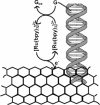Application of electrochemical biosensors in clinical diagnosis
- PMID: 24833531
- PMCID: PMC6807684
- DOI: 10.1002/jcla.20500
Application of electrochemical biosensors in clinical diagnosis
Abstract
Analyses in the clinical area need quick and reliable analytical methods and devices. For this purpose, biosensors can be a suitable option, whereas they are constructed to be simple for use, specific for the target analyte, capable of continuous monitoring and giving quick results, potentially low-costing and portable. In this article, we describe electrochemical biosensors developed for clinical diagnosis, namely for glucose, lactate, cholesterol, urea, creatinine, DNA, antigens, antibodies, and cancer markers assays. Chosen biosensors showed desirable sensitivity, selectivity, and potential for application on real samples. They are often designed to avoid interference with undesired components present in the monitored systems.
Keywords: amperometric; analysis; biosensor; clinical diagnosis; enzyme.
© 2012 Wiley Periodicals, Inc.
Figures



References
-
- Rechnitz GA. Biosensors: An overview. J Clin Lab Anal 1987;1:308–312.
-
- Rechnitz GA. Future of biosensors in the clinical laboratory. J Clin Lab Anal 1988;2:131–133.
-
- Kissinger PT. Biosensors‐a perspective. Biosens Bioelectron 2005;20:2512–2516. - PubMed
-
- Malhotra BD, Chaubey A. Biosensors for clinical diagnostics industry. Sensor Actuator BChem 2003;91:117–127.
-
- Velasco‐Garcia MN. Optical biosensors for probing at the cellular level: A review of recent progress and future prospects. Semin Cell Dev Biol 2009;20:27–33. - PubMed
Publication types
MeSH terms
Substances
LinkOut - more resources
Full Text Sources
Other Literature Sources
Medical

